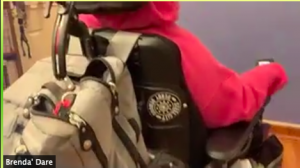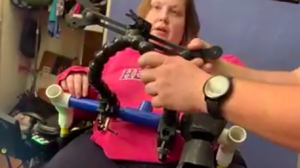Introduction
In order to begin our final project of creating an assistive device specifically catered to address the needs of a disabled person, our team of Claire and Arleen, along with Mimi and Carl, interviewed our target that we would me making an assistive device for, Brenda. Of course, due to the special circumstances of the semester being virtual, our anticipated end result would be as close to a cohesive product as possible, like including a prototype, schematic, simulator version, and more, but not a physical working final end product. By interviewing her, we got a better sense of her lifestyle and particular needs depending on the struggles she experienced in her day-to-day life.
Agenda
Before our interview, we prepared some possible questions to ask her in anticipation of how she might respond or how we might help her extract and identify problems in her daily life should the need arise. Our agenda is below:
Interview Questions
- How are you? How are you doing? What did you do today (but don’t be so direct?)?
- Ask permission to record interview
- Clarify project goals and purpose of today’s interview to get ideas, also mention we are not professionals so we’re not building an actual device
- Have there been any sort of frustrations or difficulties in your life recently? (Both physically and mentally) (Ask follow ups and start ideating if we get a lead from this)
- If it seems like she’s having a difficult time thinking of one from top of her head try to lead her by giving her examples) conducting your job / mobility issues / communication (esp. During video calls)
- Backup/guiding questions:
- What is your daily routine like?
- Can you demonstrate any task you find somewhat difficult?
- What kind of tools do you use? What kind of improvements would you like to make to these tools? Is there any that you think would be useful but you don’t have/doesn’t exist yet/too unreasonably expensive to get?
*Ask what she does and then wait for the answer – and as a follow up ask how she does it.
Summary/Takeaways
Our meeting mostly consisted discussing ideas of problems Brenda thought up prior to the meeting (we didn’t have to do much digging for issues). Going into the meeting, she already had a good sense and awareness of the daily life and came well-prepared with several ideas to share with us, which we recorded in our notes and present below:
- Idea 1: Brenda has good use of right side of body (better than her left, but lost some range in shoulders due to age so she can’t grab the backpack from behind her chair, so having some sort of button or lever to bring backpack to side and put back behind her chair easily would make retrieving things more convenient.
- Some considerations were that there were already several moving parts to her chair we could not interfere with, and such a design would need mechanical infrastructure.

A visual of how Brenda’s backpack strapped onto the back of her chair currently looks like
- Idea 2: Have a remote control to move table stand around to fine tune without having to manually adjust; a possibility is to mount a motor to have driver to adjust for better visual interaction.
- The table stand has a square base around 20 pounds, so the base to control the stand would have to be very sturdy.
- Idea 3: There’s no flat point on back of her phone case to attach a pop socket or kickstand to hold it up well, and her phone is too big to pick up herself with commercial reachers when she drops it.
- Idea 4: She cannot reach her foot plates since its too far down, so she wants to automate or make flipping the foot plates easier.
- Idea 5: Her tablet supporter is a little bulky so she wants to automate it into a swinging tablet stand that is safe and stable to conserve space.

Brenda’s current tablet stand is shown; it takes up her entire armrest so she wants to be able to move it away easily
- Idea 6: Brenda can’t open windows herself, and she dislikes AC but likes fresh air coming in, so she wants an automatic window opener or something for her favorite window since commercial ones are too expensive.
- Idea 7: She has an overhead lift from bedroom to bathtub to drop her into the tub, can’t reach faucet to turn water herself because of placement from where sitting in the tub.
Through our discussion of ideas, we also got a better sense of exactly how she was disabled, information which may be useful later on when making considerations for the design solutions to her problems. We compiled our list of her limitations and preferences below:
- Brenda has very limited movement on the left side of her body, so mostly any mobility is done with her right side.
- This has led to full extension capability in her right arm and half extension of her left arm.
- She lacks coordination in her arms and wrists, but she can move her fingers easily.
- She can occasionally move her legs, but not by much.
- Her vision is not great.
- She has limited shoulder range and movement due to her age.
- Brenda already possesses a lot of assistive technologies and has a lot of knowledge in this area, so many of her ideas actually revolve around automating items she already owns.
- In her daily life, she likes to cook, spends lots of time in her car, and enjoys feeling like she has free space to move around, thus preferring assistive devices that don’t increase clutter, but actually allow her the functionality of stashing them away.
Discussion
We found the meeting very insightful as it was the first time either of us had done an interview like this before, in which we were trying to find out more about a person’s life to identify any problems we could solve for them. Going in, we definitely expected it to be a lot more difficult to extract ideas from Brenda’s daily routine, but it was very unexpected when we went into the interview with several supplemental questions prepared only for her to dive straight into presenting her ideas based on problems and inconveniences she realized herself.
It was definitely a relief on our end that she was so decisive and direct with her ideation, however, as the interview progressed with her presenting more and more of her problems and solution ideas, we started to realize a trend in which many of her issues actually had mechanical solutions rather than electrical ones that were somewhat beyond the scope of this course. For example, the phone stand supporter was a purely mechanical issues that would require no electrical, especially no Arduino, components to solve. The same goes for the tool that would help rotate her backpack – it would require carefully designed customized mechanical parts rather than electrical. After the interview, it was slightly disappointing that we didn’t walk away with any stellar ideas that we were confident in, as all the solutions were easy to turn into electrical devices.
Looking back, we definitely would’ve liked to clarify the scope of our project and abilities a bit further, emphasizing that our solutions would need to focus heavily on the electrical portions, which might have steered the conversation in a different direction and led to some other problem ideas better suited for our skill set. We hope to speak to Brenda once more to discuss the ideas in a new direction and try to gear them more towards including electrical components – if time and schedule allow.